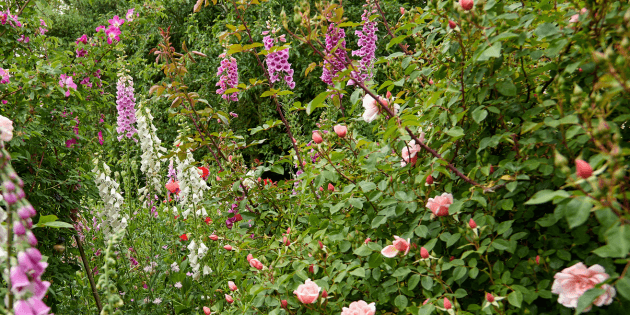Designing sustainable landscapes for a climate-challenged future.
By Rose Morrison, managing editor of Renovated and The Landscape Guide.
Drought-proofing your landscape is quickly becoming necessary if you want your outdoor space to survive a changing climate. Droughts are happening more often and lasting longer, and how you’ve always handled your yard may not cut it anymore. Traditional lawn maintenance and constant sprinkler use waste water and often fail when the heat hits hardest.
You’re not alone if you’ve ever watched your plants wilt or your water bill spike during a dry spell. The good news is you don’t have to give up a beautiful yard to save resources. With climate adaptation strategies, you can create a thriving, eco-friendly landscape that can handle tough weather using far less water. It starts with a shift in mindset — from forcing your yard to fit an outdated mold to designing one that works harmoniously with your local climate.

Why Drought-Proof Landscaping Matters
Drought goes beyond a dry lawn. It impacts your entire community and surrounding environment. When there’s not enough water, rivers run low, soil quality drops and local wildlife struggles to survive. At the same time, you might feel the effects in your own life through higher food prices and health risks from dusty, dry air. Between 1980 and 2023, the U.S. faced 31 major droughts, each causing over $1 billion in damages, and the trend is only getting worse.
Water scarcity is quickly becoming the new normal in many parts of the country, not just the dry Southwest. It’s important to rethink how you manage your outdoor space. By shifting to sustainable landscaping, you can lower your water use, ease the burden on local ecosystems and still enjoy a beautiful, thriving yard that works with the climate.
Understanding Your Local Climate and Soil

Before you jump into climate change adaptation strategies, take time to understand your local conditions. It’s one of the smartest things you can do for long-term success. Start by looking at your regional weather patterns, typical rainfall and how often your area faces drought. This information gives you a clear idea of what your landscape will need to withstand conditions throughout the year.
Then, dig a little deeper — literally. Testing your soil tells you about its texture, drainage and organic matter, which affect how well plants can grow and how much water they’ll need. Remember to factor in your specific climate zone and any microclimates in your yard. Microclimates include shaded areas or slopes, which can influence plant selection and irrigation placement.
Even grass, which seems so simple, has limits. It stops growing when temperatures drop below 50 to 55 degrees Fahrenheit or rise above 90 degrees Fahrenheit. Since soil warms and cools more slowly than air, these changes take a few days to affect grass growth. Knowing these details helps you choose the right plants, plan efficient watering and create a landscape built to thrive.
Principles of Xeriscaping
Xeriscaping reduces or eliminates the need for supplemental irrigation, which makes it ideal for dry regions or anyone aiming to conserve water. It involves smart planning and plant choices and a design that works with nature. Xeriscaping follows seven core principles:
- Planning and design: Start with a thoughtful layout based on your yard’s sun, shade and drainage.
- Soil improvement: Enrich your soil to retain moisture.
- Efficient irrigation: Use methods like drip systems and water only when needed.
- Plant selection: Choose native or drought-tolerant species.
- Mulching: Cover soil to reduce evaporation and weeds.
- Turf management: Minimize lawn areas or use low-water grass varieties.
- Ongoing maintenance: Regularly check plants, prune and adjust as your landscape matures.
Landscape sustainability is more relevant than ever with climate concerns on the rise. This approach helps create a beautiful, sustainable yard that saves water and supports your local ecosystem.
Choosing the Right Plants
When drought-proofing your landscape, the plants you choose make a huge difference. Focus on native and drought-tolerant species, as they can handle your local climate and usually need less fertilizer and care. You can create a garden that’s water-efficient and full of life.
Start with perennial ground covers like creeping thyme or ice plant to help lock in soil moisture. Add structure and beauty with low-water shrubs like lavender, sage or bottlebrush. Succulents such as agave and Echeveria bring bold shapes and store water well, which makes them perfect for dry conditions. Ornamental grasses like fountain grass, blue fescue and muhly grass offer texture and movement without demanding constant attention.
Sustainable landscaping allows you to design a yard that works with the climate. Prickly pear and yucca thrive in hot, arid zones. Meanwhile, rosemary, rockrose and olive trees do great in more temperate areas. For a pollinator-friendly boost, try adding black-eyed Susans or coneflowers. You can also mix in edible drought-tough plants like chili peppers and thyme. Your yard can save water and support local wildlife with the right plant choices.
Capturing and Reusing Water

One of the smartest ways to approach drought-proof landscaping is by capturing and reusing your existing resources. Rain barrels, greywater systems and swales are practical tools that let you make the most of every drop. Rain barrels collect water from your roof and store it for garden use, which gives you a steady supply that matches rainfall patterns.
Greywater systems take lightly used water from sinks, showers or laundry machines and divert it to irrigate non-edible plants. Swales help slow and spread rainwater across your yard, giving it time to soak in rather than run off. These systems reduce your reliance on municipal water, lower your bills and keep your garden hydrated during dry spells.
If you have a roof, you already have a catchment system, so add a rain barrel and redirect that runoff to your plants. It’s a simple upgrade with a big impact. But before you start installing, make sure to check your local regulations. Some areas have rules about water reuse or rainwater collection, especially if you connect systems to your home’s plumbing. Once you’re clear on the regulations, these tools can become crucial for maintaining landscape sustainability.
Smart Irrigation
If you want to water smarter, drip irrigation, soaker hoses and smart controllers are your best friends. Drip irrigation and soaker hoses deliver water right to the base of your plants, so you lose less to evaporation and runoff. These systems are perfect for garden beds, trees and shrubs, and they help you avoid overwatering while keeping your plants healthy.
To level up, use a smart controller with soil moisture sensors placed below the surface in the root zones of your yard. These sensors check your soil’s moisture levels and only function when your plants truly need them. That means you’re not guessing or wasting resources on a timer that may not reflect real conditions.
Water deeply and less often to help roots grow stronger and more drought-resistant for best results. Timing is also crucial, as watering early in the morning or evening makes the liquid less likely to evaporate before it reaches the roots. With climate adaptation strategies, you’ll save time and give your garden what it needs to thrive.
Soil Health and Mulching
Healthy soil is the foundation of drought-proof landscaping, and adding organic matter is one of the best ways to improve it. Compost, worm castings and biochar help your soil retain moisture, making it easier for plant roots to access the water they need in dry conditions. This boost in retention also strengthens plant resilience, which helps them stay green and productive through heat waves or water restrictions.
On top of that, don’t underestimate the power of mulch. According to Dr. Fonteno, a professor emeritus of horticultural science at North Carolina University, it is a physical barrier that blocks weed seeds from settling in. That’s a big deal because successful weeds can steal up to 25% of the moisture your plants need.
Spreading a layer of mulch over your soil locks in moisture and regulates temperature. Whether layering compost into your beds or mulching around your shrubs, these simple climate change adaptation strategies significantly impact how your landscape handles drought.
Hardscaping and Permeable Surfaces

If you’re looking for a low-maintenance way to upgrade your landscape architecture in the face of climate change, cut back on traditional lawn areas and replace them with smart, stylish alternatives like gravel, pavers or decomposed granite. These materials help your yard work better, especially in dry or unpredictable weather. When you use permeable surfaces, you allow rainwater to soak into the ground rather than run off, which reduces erosion and filters out pollutants that could affect your local water quality.
That’s a big win for your garden and the environment. Plus, you can use these materials to create beautiful and functional features like stone walkways or rain gardens that collect and manage stormwater naturally. These spaces make your yard more inviting and easier to care for — no mowing, no wasted water, just smart, sustainable design that fits your lifestyle.
Why Your Yard Matters More Than Ever
Drought-proof landscaping is more than a trend. It’s an environmental necessity and a smart, long-term investment in the health of your home and planet. By rethinking how you design and care for your yard, you can conserve water, reduce waste and support local ecosystems. Your landscape is a powerful tool in the fight against climate change.

About the Author
Rose is the managing editor of Renovated and has been writing in the construction, landscaping and sustainable building sectors for over six years. She’s most passionate about improving environments, reducing carbon footprints and incorporating resourceful methods to promote well-being in the planet. For more from Rose, you can follow her on Twitter and connect on LinkedIn.